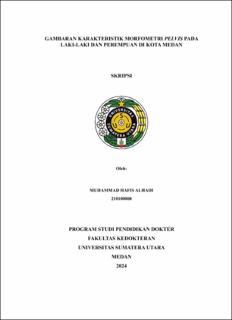| dc.description.abstract | Background: Variations in pelvic morphometry have significant implications for
reproductive health, body biomechanics, and obstetrics. Sexual dimorphism, age, and
ethnicity are key factors influencing the distribution of pelvic shapes and dimensions.
However, descriptive data on the local population in Medan remains limited. Objective:
This study aims to analyze the distribution of pelvic morphometry shapes and
dimensions in males and females based on age and ethnicity in Medan. Methods: A
descriptive cross-sectional study was conducted using secondary medical record data
from 143 patients at RSUP Haji Adam Malik, selected through quota sampling, and
analyzed using SPSS. Results: The study revealed the dominance of android pelvic
shapes in males (97.96%) and platypelloid (54.26%) as well as gynecoid (35.11%)
pelvic shapes in females. Transverse pelvic dimensions were significantly larger than
anteroposterior dimensions (12.31 cm : 10.88 cm), reflecting morphological
adaptations for reproductive and biomechanical functions. Age-based variations
showed a dominance of android shapes in younger groups and a transition to gynecoid
and platypelloid shapes in middle-aged and older groups. Ethnic variations indicated
that android shapes were more common among Batak (45.90%) and Javanese
(46.81%) populations, while platypelloid shapes dominated among Malays (60%).
Conclusion: This study demonstrates the dominance of android pelvic shapes in males,
while platypelloid and gynecoid shapes are more common in females. Age-related
variations indicate a transition from android shapes in younger groups to gynecoid in
adults and platypelloid in older groups. Ethnic distribution shows the dominance of
android shapes among Batak and Javanese, while platypelloid shapes are more
frequent among Malays. The larger transverse pelvic dimensions compared to
anteroposterior dimensions reflect adaptations for biomechanical and reproductive
needs. | en_US |


